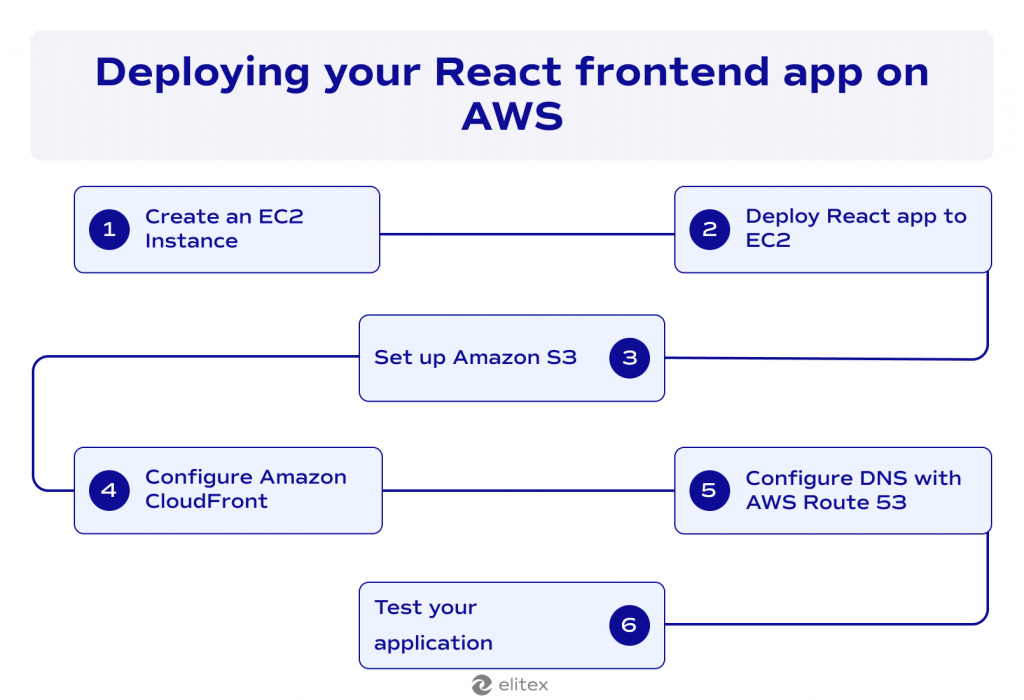Have you ever found yourself needing to deploy React frontend on AWS? While this task might seem daunting or complex due to the technical jargon and vast array of services involved, it’s actually quite straightforward once you break it down. The process doesn’t require you to be DevOps or have experienced front-end developers under your belt. All we need for today is a very basic understanding of web development and AWS fundamentals. By demystifying each step, we’ll see that deploying your React application is a manageable and logical sequence of actions.
Overview of deploying a React application on AWS
Disclaimer: We have previously written a separate article about how you can deploy your simple web application to AWS with Bitbucket, and today, we will speak about deploying with EC2 and other built-in Amazon tools.
In this case, we will need:

- Amazon EC2: This service will allow us to run the React app on virtual servers in the cloud. Here, in EC2, we can choose from various configurations of CPU, memory, storage, and networking capacity for our EC2 instance, which will serve as the server hosting our React app.
- Amazon S3 (Simple Storage Device): Although our application will be served by EC2, S3 can still be used to store static assets like images, stylesheets, and JS files that don’t need server-side processing (server-side rendering just won’t work with S3). These can be served efficiently to app users, potentially through a CDN like Amazon CloudFront. Pay attention to the fact that S3 and EC2 can work separately or together. In our particular case, we will combine them.
- Amazon CloudFront: In our case, integrating CloudFront can enhance the performance at edge locations closer to your users. This setup reduces latency and improves the loading speed of your React app, even though the dynamic content is served from EC2.
- AWS Route 53: This service will handle DNS management for your application, directing app users to your EC2 instance or CloudFront distribution. It’s essential for managing the domain and ensuring user requests are routed correctly.
Together, these services create a robust environment in which we can deploy React apps on AWS. They provide the necessary tools to manage traffic, optimize performance, and ensure that your app remains accessible and responsive to your users.
What are the procedures for hosting a React JS frontend on AWS?
A full deployment process with chosen tools involves a series of steps that configure each service to work seamlessly together. Together, they ensure a smooth, efficient, and scalable deployment. However, let’s do everything step-by-step.
Step 0: Before we start
First, we must prepare everything to deploy our React frontend on AWS. Preparing everything adequately will save you time and help avoid common pitfalls. Here’s what we need to do:
- Understand AWS services
Familiarize yourself with the AWS services we will use: EC2, S3, CloudFront, and Route 53. Understanding what each service does and how they interact will greatly aid in troubleshooting and efficiently configuring your deployment.
- Set up an AWS account
If you don’t already have an AWS account, create one on AWS’s website. Familiarize yourself with what AWS offers for free and potential service usage exceeding the free tier limits.
- Install required software
Ensure your local development environment is set up for React development and AWS deployment. Also, ensure you have Node.js and NPM, AWS Command Line Interface (CLI), and Git (if your code is version-controlled with Git, for sure).
- Prepare your React app
Test and build your React app locally. Ensure it’s fully functional and free of bugs. Run “npm run build” to create a production build of your application. Then, set up any environment variables or configuration files your application requires. These might include API keys, service endpoints, or custom settings specific to the product environment.
- Secure your AWS resources
Set up AWS IAM users and roles. It’s a best practice to operate with the least privilege necessary to accomplish tasks. Review and configure security groups and other network access settings to ensure your AWS resources are securely accessible. Only open ports are necessary, and API addresses can be restricted from accessing your EC2 instances as needed.
- Review AWS pricing and budget
Then, set a budget in AWS to monitor your spending and receive alerts if costs exceed your anticipated usage. You can also read the guide to our AWS cost optimization tool, which can greatly help control your cloud expenses.
Now, we can proceed with deploying the React frontend on AWS.

Step 1: Create an EC2 instance
- Navigate to the EC2 dashboard in the AWS Management Console
- Click on “Launch Instance” to create a new EC2 instance.
- Choose an appropriate Amazon Machine Image (AMI) that suits your application needs, such as an Amazon Linux AMI or Ubuntu server.
- Select the instance type (e.g., t2.micro) and configure the instance settings, including VPC and subnet details.
- Add storage if the default storage options do not meet your requirements.
- Configure the security group to allow traffic on necessary ports, typically port 80 (HTTP) and 443 (HTTPS).
- Launch the instance and not the public DNS or IP address.
Step 2: Deploy React on AWS (to EC2)
- Connect to your EC2 instance using SSH (it will be a regular copy built on a pipeline).
- Once connected, install Node.js and NPM if not already installed.
- Clone your React application repository or transfer your React build files to the EC2 instance.
- Install any dependencies and build your project if necessary.
- Run your React app using a suitable Node.js server, such as Express.js, or serve it using Nginx or Apache.
Step 3: Set up Amazon S3
- Go to the S3 service in the AWS Management Console and create a new bucket.
- Set the bucket permissions to enable public access if your static files need to be accessible to the public.
- Upload static files like CSS, JS, and image assets to the S3 bucket.
Step 4: Configure Amazon CloudFront
- Navigate to the CloudFront dashboard.
- Create new distributions and select your S3 bucket and EC2 instance as the origin.
- Set the desired configuration options, such as cache behavior and distribution settings.
- Once the distribution is created, take note of the CloudFront domain name.
Step 5: Configure DNS with AWS Route 53
- Go to the Route 53 dashboard.
- Create a new hosted zone for your domain.
- Add record sets in your hosted zone to connect your domain to the CloudFront distribution and directly to the EC2 instance IP. We need to set up both the main site (myfrontend.site) and the static subdomain (static.myfrontend.site)
Step 6: Restart your web server:)
Step 7: Test your application
Ensure that your domain name correctly resolves and that your React application is accessible via the Internet. Check for any errors and confirm that the application loads efficiently with the intended performance enhancements provided by CloudFront.
Advanced strategies to deploy React frontend on AWS

AWS Amplify
AWS Amplify simplifies the process of deploying web applications by seamlessly handling the backend configuration and deployment. It also provides an easy-to-use interface for deploying full-stack applications and managing cloud services. This service supports a variety of frontend frameworks, including React, and automates tasks like authentication, API creation, and serverless functions, allowing developers to focus more on the user interface and user experience.
Templates
Templates are pre-configured sets of resources that define how applications and their dependencies should be instantiated and managed. For example, AWS CloudFormation templates allow you to describe your desired resources and their relationships, enabling consistent deployments across environments. This method ensures that infrastructure can be replicated quickly and with fewer errors, facilitating a more organized and predictable deployment process.
Git
Git is a version control system that allows multiple developers to work together on code without conflicts. It’s integral to modern deployment strategies for managing code changes and maintaining a history of modifications. Git can be paired with continuous integration/continuous deployment (CI/CD) tools to automate the deployment process, ensuring that updates can be pushed to production through a systematic, traceable approach.
Automating deployments
Automating deployments involves using various tools and techniques to move code from development to production environments automatically. This approach minimizes human errors and increases efficiency in software development cycles. All of the three strategies mentioned above can be used for automation. We can use them separately, combine them with each other, or add some third-party automation tools. Tools, such as Jenkins or GitHub Actions, can perform tests, build code, and deploy applications to various environments based on predefined triggers, ensuring that software can be reliably and consistently released at a faster pace.
Final Thoughts
We hope our guide helped you demystify an AWS deployment process. Here, we provided a practical roadmap for deploying your React application on AWS, from setting up the initial AWS environment to testing your app after the deployment. However, you still need to remember that the deployment is just the beginning of the path. Continuous improvement based on feedback, monitoring insights, and evolving technologies will keep your application at the forefront of efficiency and user satisfaction.
If you need any further help deploying your React frontend on AWS, don’t hesitate to contact ELITEX. Whether you need an experienced DevOps services provider or are just looking for further advice on how to connect frontend and backend of your application, contact us. Choosing ELITEX always means choosing a development partner beyond your initial expectations.

FAQs
How to deploy React frontend on AWS?
Upload build files to S3, set up CloudFront, and point DNS with Route 53.
How to connect React.js frontend with AWS backend?
Use API Gateway and Lambda for serverless backend or connect directly to EC2 via HTTP.
How to connect AWS EC2 express API and React frontend?
Point React’s API requests to the public IP or domain of the EC2 instance running Express.
How do I choose the right AWS services to host my React app?
Use EC2 for flexibility, S3 for static sites, and add Elastic or Beanstalk for scaling.
What are the prerequisites for deploying a React application on AWS?
AWS account, configured React build, knowledge of AWS services (EC2, S3, IAM).
Let’s talk about your project
Drop us a line! We would love to hear from you.













